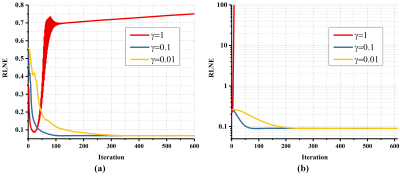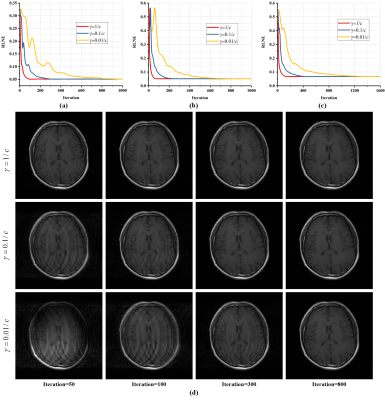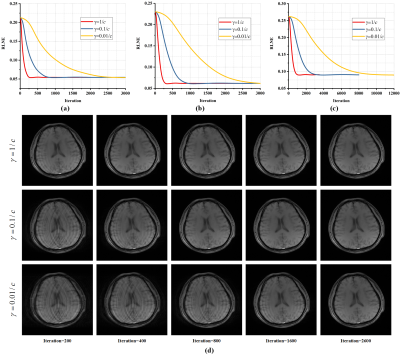3492
A Convergence Proof of Projected Fast Iterative Soft-thresholding Algorithm for Parallel Magnetic Resonance Imaging1Department of Electronic Science, Fujian Provincial Key Laboratory of Plasma and Magnetic Resonance, Xiamen University, Xiamen, China, 2School of Computer and Information Engineering, Fujian Provincial University Key Laboratory of Internet of Things Application Technology, Xiamen University of Technology, Xiamen, China, 3Neusoft Medical System, Shanghai, China
Synopsis
For compressed sensing magnetic resonance imaging, algorithms plays a significant role in sparse reconstruction. The Projected Fast Iterative Soft-thresholding Algorithm (pFISTA), a simple and efficient algorithm solving sparse reconstruction models, has been successfully extended to parallel imaging. However, its convergence criterion still poses as an open question, yielding no guideline for parameter setting that allows faithful results. In this work, we prove the sufficient conditions for the convergence of parallel imaging version of pFISTA. Results on in vivo data demonstrate the validity of the convergence criterion.
Purpose
he emergence of sparse sampling and image reconstruction dramatically reduce the lengthy acquisition time of magnetic resonance imaging (MRI) 1,2. Numerous efforts have been made to design sparse MRI reconstruction methods to achieve satisfactory results, and many works have shown that reconstruction models equipped with tight frame yield better results than those with orthogonal transform 3,4 . Aiming at solving sparse MRI reconstruction problems under the tight frame, our group designed a projected iterative soft-threshold algorithm (pISTA) and its acceleration version – pFISTA 5. The pFISTA embraced low reconstruction error and fast convergence speed. Moreover, pFISTA has only one adjustable algorithm parameter $$$\gamma$$$ and its convergence criterion has been proved 5. The pFISTA, however, is limited to tackle single-coil image reconstruction problems. Recently, pFISTA has been applied to tackling parallel imaging reconstruction problems 6, such as sensitivity encoding (SENSE) method 7 and iterative self-consistent parallel imaging reconstruction (SPIRiT) 8. However, the convergence analysis of parallel imaging version pFISTA is not provided, and the convergence condition in single-coil pFISTA is not suitable for parallel imaging version pFISTA. A relatively large $$$\gamma$$$ will lead to the divergence while a far smaller one results in the slow convergence of the algorithm (Fig. 1) Therefore, it is necessary to give a clear mathematical proof of its convergence to assist setting a proper algorithm parameter.Methods
We proved the convergence of parallel imaging version pFISTA for both solving SENSE 7 and SPIRiT 8 optimization problems.The reconstruction problem based on SENSE 7 can be formulated as: $$ {{\left ( \textbf{pFISTA-SENSE} \right )}} \quad \mathop {\min }\limits_{{{\mathbf{x}}_{c}}} \lambda {\left\| {{\bf{\Psi }}{{\bf{x}}_{c}}} \right\|_1} + \frac{1}{2}\sum\limits_{j=1}^{J}{\left\| {{\mathbf{y}} - {{{\mathbf{U}}}{{\mathbf{F}}}\mathbf{C}{{\mathbf{x}}_{c}}}} \right\|_2^2},$$ where $$${{\mathbf{x}}_{c}}$$$ denotes the composite MRI image, $$${{\mathbf{y}}_{j}} \left( j=1,2,\cdots ,J \right)$$$ the undersampled k-space vector of $$$j$$$th coil, $$$\mathbf{U}$$$ the undersampling matrix, and $$$\mathbf{F}$$$ the discrete Fourier transform. $$${{\mathbf{C}}_{j}}$$$ is a diagonal matrix containing the sensitivity map of $$$j$$$th coil, and $$$\mathbf{\Psi }$$$ is a tight frame. We provide the sufficient conditions for the convergence of pFISTA-SENSE in the form of a theorem.
Theorem 1. Let $$$\left\{ {{x}^{\left( k \right)}} \right\}$$$ be generated by pFISTA-SENSE, and if the step size satisfies $$\gamma \le \frac{1}{c}, \quad c=\sum\limits_{j=1}^{J}{\left\| {{\mathbf{C}}_{j}} \right\|_{2}^{2}},$$ and $$$\mathbf{\Psi }$$$ is a tight frame, the sequence $$$\left\{ {{\alpha }^{\left( k \right)}} \right\}=\left\{ \mathbf{\Psi }{{x}^{\left( k \right)}} \right\}$$$ converges to a solution of $$\underset{\mathbf{\alpha }}{\mathop{\min }}\,\lambda {{\left\| \mathbf{\alpha } \right\|}_{1}}+\frac{1}{2}\left\| \mathbf{y}-\mathbf{UFC}{{\mathbf{\Psi }}^{*}}{{\mathbf{\alpha }}_{c}} \right\|_{2}^{2}+\frac{1}{2\gamma }\left\| \left( \mathbf{I}-\mathbf{\Psi }{{\mathbf{\Psi }}^{*}} \right)\mathbf{\alpha } \right\|_{2}^{2}.$$ The SPIRiT 8 reconstruction with $$$\ell_1$$$ constraint can be formulated as: $$ {{\left ( \textbf{pFISTA-SPIRiT} \right )}} \quad \mathop {\min }\limits_{\mathbf{x}} \lambda {\left\| {{\mathbf{\Psi x}}} \right\|_1} + \frac{1}{2} \left\| {{\mathbf{y}} - {{\mathbf U}{\mathbf{F}}\mathbf{x}}} \right\|_2^2 + \frac{\lambda _1}{2} \left\| {\left( {{\mathbf{G}} - {\mathbf{I}}} \right){{\mathbf F}\mathbf{x}}} \right\|_2^2, $$ where $$$\mathbf{x}=\left[ {{\mathbf{x}}_{1}};{{\mathbf{x}}_{2}};\cdots ;{{\mathbf{x}}_{J}} \right]$$$ denotes the multi-coil MRI image data rearranged into a column vector, and$$$\mathbf{y}=\left[ {{\mathbf{y}}_{1}};{{\mathbf{y}}_{2}};\cdots ;{{\mathbf{y}}_{J}} \right]$$$ the undersampled multi-coil k-space data. The matrix $$$\mathbf{G}$$$ consists of a series of matrices $$${{\mathbf{G}}_{j,i}} \left( i,j=1,\cdots ,J \right)$$$, which represent the linear combination weights in SPIRiT.
Also, we provide the sufficient conditions for the convergence of pFISTA-SPIRiT in the form of a theorem.
Theorem 2. Let $$$\left\{ {{x}^{\left( k \right)}} \right\}$$$ be generated by pFISTA-SPRIT, and if the step size satisfies $$ {\gamma} \le \frac{1}{c},\quad c=1+{{\lambda }_{1}}{{\left( \sum\limits_{m=1}^{J}{\sum\limits_{n=1}^{J}{{{\left\| {{\mathbf{G}}_{m,n}} \right\|}_{2}}}}+1 \right)}^{2}},$$ and $$$\mathbf{\Psi }$$$ is a tight frame, the sequence $$$\left\{ {{\alpha }^{\left( k \right)}} \right\}=\left\{ \mathbf{\Psi }{{x}^{\left( k \right)}} \right\}$$$ converges to a solution of $$\underset{\mathbf{\alpha }}{\mathop{\min }}\,\lambda {{\left\| \mathbf{\alpha } \right\|}_{1}}+\frac{1}{2}\left\| \mathbf{y}-\left[ \begin{matrix} {\mathbf{\tilde{U}}} \\ -\sqrt{{{\lambda }_{1}}}\left( \mathbf{G}-\mathbf{I} \right) \\ \end{matrix} \right]\mathbf{F}{{\mathbf{\Psi }}^{*}}\mathbf{\alpha } \right\|_{2}^{2}+\frac{1}{2\gamma }\left\| \left( \mathbf{I}-\mathbf{\Psi }{{\mathbf{\Psi }}^{*}} \right)\mathbf{\alpha } \right\|_{2}^{2}.$$
Results
As shown in Fig. 2 and 3, for three tested brain images, when using the $$$\gamma $$$ ranged from $$$0.01/c$$$ to $$$1/c$$$, pFISTA-SENSE and pFISTA-SPIRiT empirically converge to a level of promising low relative $$$\ell_2$$$ norm (RLNE). The larger the $$$\gamma $$$, the faster the algorithms converge, and the fastest convergence speeds are achieved when $$$\gamma =1/c$$$. Thus, we recommend $$$\gamma =1/c$$$ for both pFISTA-SENSE and pFISTA-SPIRiT experiments.Conclusion
In this work, we proved the sufficient conditions for the convergence of parallel imaging version pFISTA, including pFISTA-SENSE and pFISTA-SPIRiT, for solving spare reconstruction models. Experimental results demonstrate the validity and effectiveness of the convergence criterion. This work is expected to help users quickly choose a proper parameter to obtain faithful results and fast convergence speed and to promote the application of sparse reconstruction.Acknowledgements
This work was supported in part by National Key R&D Program of China (2017YFC0108703), National Natural Science Foundation of China (61971361, 61571380, 61871341, 61811530021, U1632274, 61672335 and 61671399), Natural Science Foundation of Fujian Province of China (2018J06018), Fundamental Research Funds for the Central Universities (20720180056), Science and Technology Program of Xiamen (3502Z20183053), and China Scholarship Council (201806315010).
The correspondence should be sent to Dr. Xiaobo Qu (Email: quxiaobo@xmu.edu.cn).
References
[1] D. L. Donoho, "Compressed sensing," IEEE Transactions on Information Theory, vol. 52, no. 4, pp. 1289-1306, 2006.
[2] D. D. M. Lustig, J. M. Pauly, "Sparse MRI: The application of compressed sensing for rapid MR imaging," Magnetic resonance in medicine, vol. 58, no. 6, pp. 1182-1195, 2007.
[3] Y. Liu, J.-F. Cai, Z. Zhan, D. Guo, J. Ye, Z. Chen, X. Qu, "Balanced sparse model for tight frames in compressed sensing magnetic resonance imaging," PloS one, vol. 10, no. 4, p. e0119584, 2015.
[4] X. Qu, D. Guo, B. Ning, Y. Hou, Y. Lin, S. Cai, Z. Chen, "Undersampled MRI reconstruction with patch-based directional wavelets," Magnetic resonance imaging, vol. 30, no. 7, pp. 964-977, 2012.
[5] Y. Liu, Z. Zhan, J.-F. Cai, D. Guo, Z. Chen, and X. Qu, "Projected iterative soft-thresholding algorithm for tight frames in compressed sensing magnetic resonance imaging," IEEE Transactions on Medical Imaging, vol. 35, no. 9, pp. 2130-2140, 2016.
[6] S. T. Ting, R. Ahmad, N. Jin, J. Craft, J. Serafim da Silveira, H. Xue, and O. P. Simonetti, “Fast implementation for compressive recovery of highly accelerated cardiac cine MRI using the balanced sparse model,” Magnetic Resonance in Medicine, vol. 77, no. 4, pp. 1505–1515, 2017.
[7] K. P. Pruessmann, M. Weiger, M. B. Scheidegger, and P. Boesiger, "SENSE: Sensitivity encoding for fast MRI," Magnetic resonance in medicine, vol. 42, pp. 952-962, 1999.
[8] M. Lustig and J. M. Pauly, "SPIRiT: Iterative self-consistent parallel imaging reconstruction from arbitrary k-space," Magnetic resonance in medicine, vol. 64, no. 2, pp. 457-71, 2010.
Figures


